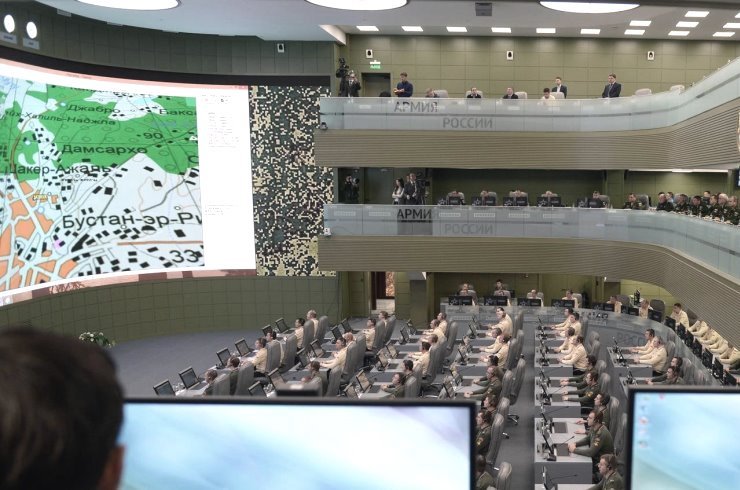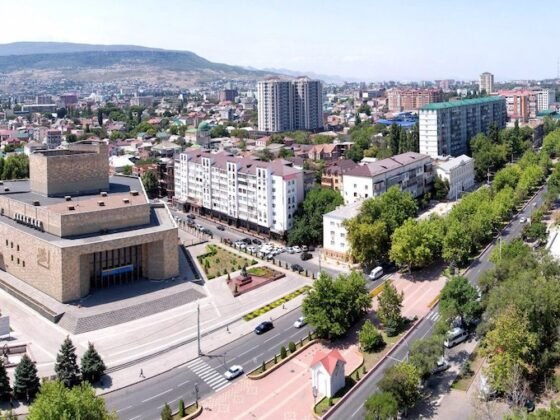(PONARS Eurasia Policy Memo) Syria has been an ongoing major focus in Russian security policy since its astounding military intervention in September 2015. Yet, now, it is barely present in political debates and news flows in Moscow. Attention began to dissipate in early March after the Russian-Turkish ceasefire agreement in rebel-held Idlib province that placed Russia’s total victory out of reach. By the end of March, the explosion of the COVID-19 pandemic had become the dominant theme across Russia and the region. Even though the virus arrived in Russia after it had entered European states, the Russian leadership found itself badly unprepared. Russia, Turkey, and Iran—all primary managers of the Syrian war—are among the worst pandemic-affected states in the world. Although the situation in Syria and Syrian refugee camps is rather nebulous, it is essential for the many stakeholders in this evolving disaster to receive some signs about possible changes in the near COVID-19-distorted future. This analysis attempts to provide a few clues to the probable shifts in Russia’s Syrian engagement coerced by its shortages of funds and resources, disagreements with Turkey and Iran, and fears about deepening domestic troubles. Under the specter of renewed upheavals in the Middle East (and beyond) and facing reality checks on multiple fronts in 2020, Russian policymakers have scaled back their international ambitions.
The Intervention Takes a Pause
At the start of 2020, the Russian high command was set on ending the Syrian war by scoring a decisive victory. The Turkish invasion of Kurdish-held territories in northern Syria was seen as a useful development. It created the perfect conditions for a new deal in which the expansion of the Turkish “buffer zone” would be traded for Russia’s long-coveted goal: conquering the last rebel-held province: Idlib. This territory, overcrowded with jihadists of all persuasions, sits close to the main Russian airbase Khmeimim, which has come under multiple drone and missile attacks. The Syrian army, with support from Russian airstrikes, began the long-planned offensive and captured about a third of the designated area, but then it ran into stiff resistance from Turkish-backed militia and even the Turkish army.
President Recep Erdoğan had taken a far more resolute stance than Moscow had expected and raised the stakes by moving thousands of Turkish troops into Idlib, exposing them to Russian airstrikes. Forced to back off from a direct clash with Turkey, Putin accepted a compromise not of his liking: terminating the offensive operations. Russian Defense Minister Sergei Shoigu traveled to Damascus in late March (breaking quarantine rules) to impress upon Syrian leader Bashar al-Assad the imperative of observing the ceasefire, in which he had no say. Hostilities indeed stopped, and Turkey began consolidating its control over northwestern Syria. In retrospect, the concession to Erdoğan’s firmness was one of the first in the series of Putin’s reckonings with reality, and it provides the initial clue to the pattern of Russia’s setbacks.
The Costly Oil Blunder
Simultaneously with stepping away in Idlib, Moscow opted to break the OPEC+ cartel arrangement on oil production cuts, unleashing a price war in the energy market. The attempt to play hardball backfired as Saudi Arabia increased its flexible output and prices dived below the level acceptable for Russian producers. The circumstances behind the elementary miscalculation by the decisionmakers who are supposed to excel at managing the oil-and-gas business make a fascinating story, but what is relevant here is the forced concession by the Kremlin to re-negotiate the OPEC+ deal and to accept far harder cuts than previously penciled. Whether a phone call from President Donald Trump made a difference cannot be established for a fact, but Putin had to perform humiliating back-pedaling.
The quarrel did not help rehabilitate relations with Saudi Arabia, and neither did it secure the recovery of the oil price that collapsed in mid-April to a level unseen in the Putin era. The impact of this unexpected disappearance of export revenues for Russia’s budget is yet to be assessed and internalized, but it is clear that the economic stagnation, which followed the crisis of 2014-16, has turned into a sharp and protracted recession. The inexperienced government of callow Prime Minister Mikhail Mishustin struggles with the task of re-distributing shrinking cash flows toward long-neglected health services and other social programs. Russia’s foreign policy, and the unpopular engagement with Syria in particular, is set to feel a severe contraction of available resources, and this constitutes an important clue for this investigation.
Curtailed Overseas Adventures
Building on the perceived success in Syria in the late 2010s, Moscow developed a propensity for deploying various “hybrid” influence and warfare means, including sending bands of mercenaries—the Wagner group being the most well-known—for low-risk engagements in far-away conflicts, particularly in Africa. The messy war in Libya became one of the targets for this experimentation, and the reinforced motley troops of self-proclaimed field-marshal Khalifa Haftar very nearly captured Tripoli in April 2019. As the offensive lost momentum, Russia tried to claim a key role in peace bargaining in early 2020, but maverick Haftar refused to play along. As Turkey moved resolutely in support of the Fayez al-Sarraj government in Tripoli, Moscow opted to back off and abstained from sending more “Wagners” into the fight. The apparent indifference to a new turn in the bad war signals Russia’s readiness to discontinue the troublesome enterprise, unless the information on the deployment of a squadron of Russian fighters to Libya signifies a decision to throw good forces after bad.
The engagement in Venezuela was of a different kind and with higher stakes as Russia became a major sponsor for the Maduro regime, which withstood mass opposition and defied sustained U.S. pressure. It was Rosneft that played the key role in building the connection, but its CEO, Igor Sechin, figured out that the risk of U.S. sanctions became prohibitive, so he managed to dump the Russian assets acquired in Venezuela into a state-owned shell company. The Russian Foreign Ministry described the U.S. indictment of Maduro for narco-trafficking as “absurd,” but the Kremlin is apparently prepared to write off the investments in this trouble-rich petro-dictatorship. In most other oversees endeavors, from the Central African Republic to Nauru, Russia has operated on small budgets and symbolic investments, so reducing this outreach is cost-free.
The Iranian Connection
The crucial condition that made possible the execution of Russia’s intervention in Syria and ensured its success was its military partnership with Iran, albeit loaded with mutual suspicions and misgivings. High-level political dialogue with Turkey, with all its tensions, has always worked better for Russia than the insincere pledges to good-neighbor tradition with Iran. The instant failure of the agreement on Russian access to an Iranian airbase in August 2016 is characteristic of discord in this pseudo-alliance. Practical cooperation in the Syrian battlefields was also contentious; Russia, for that matter, has never provided any protection to Iranian assets from Israeli airstrikes despite pledges to upgrade the Syrian air defense system. Russian military advisers had very different plans for building regular corps in the Syrian army than instructors from the Iranian Revolutionary Guard, who worked closely with various militia including Hezbollah.
This pattern of interaction is undergoing profound changes that are mostly invisible due to the anxieties caused by the COVID-19 pandemic. Iran is one of the worst-hit states in the world, and its attempts to enforce a lockdown clash with the need to stimulate the economy, which is badly affected by U.S. sanctions. A near-complete disappearance of oil revenue determines that there will be a deep reduction of Iranian aid to the Assad regime and, in particular, cuts in sponsorship of various militia. The elimination of the only authority capable of keeping these marauders under control, namely General Qasem Soleimani, leaves them free to engage in extortion and gang warfare in all major Syrian urban centers.
Russia cannot possibly compensate for the shrinking of Iranian investment in the Syrian regime’s consolidation since it has lways sought to execute the military intervention on the cheap. Further, the unraveling of political order and sovereign default in Lebanon caused by the curtailing of Saudi sponsorship of the Saad al-Hariri government and Iranian funding for Hezbollah provides a clue to the probable threat to Russia’s positions in Syria.
Shadows of Revolution
The Kremlin conceptualized the Syrian intervention as a forceful move against the threat of revolutions sponsored and manipulated by the United States and spreading from the Arab world into the Black Sea area and Russia. This counter-revolutionary offensive was seen as impactful in turning back this dangerous tide, and the Velvet Revolution in Armenia in the spring of 2018 was ignored in Moscow as an unfortunate deviation from the trends of autocratic resurgence and diminishing Western influence. Signs of a gathering new storm in 2019—from Hong Kong to Algeria—were worrisome, but the pandemic lockdowns in the springtime of 2020 have extinguished most street protests. The still deepening economic disaster is certain, however, to produce so much public discontent that democracies should expect turmoil and dictatorships need to fear mass uprisings.
When a new wave of upheaval sweeps across the Middle East, which is a plausible assumption given the intensity of social conflicts suppressed since the Arab Spring, Syria will hardly constitute an eye of this storm. A revival of ISIS, predicted by many strategic scenarists, remains a serious risk, but Sunni jihadists would not be able to attract external funding (due to its general shortage) or volunteers. Moscow will have to ponder how much sense it makes to remain committed to the increasingly costly engagement in a peripheral if familiar conflict zone when more important states, particularly in the Black Sea region and in Central Asia, are engulfed by instability. Those in the Kremlin are certain to remain strongly opposed to revolutions, but their counter-revolutionary zeal will have to be focused on feasible targets to prevent an explosion of public anger at home.
Conclusion
The collection of clues that can be gathered from examining recent decisions in Moscow and probable responses to the now-apparent challenges cannot provide a reliable guide to the shifts in the Kremlin’s behavior in the uncomfortably uncertain near future. Even the material parameters of pending choices are fluid since the impact of the expected economic contraction on the capabilities for projecting power can only be guessed rather than evaluated. For that matter, the spring draft into the Russian army was postponed at the last possible moment and only for a month, even if it has proven no less complicated and risky to proceed with gathering teenage conscripts in May than it was in April. Putin’s decision to stage the Victory Day military parade on June 24 (postponed from May 9) may damage his popular support rather than boost it. It is clear, nevertheless, that the realm of the possible is undergoing a radical reconfiguration so that habitual calculations of costs and benefits of using military force as an instrument of policy are distorted by new variables.
The evolution of the Syrian intervention has arrived at a dead end, as marked by the Idlib deal with Turkey, which signified the unattainability of a total victory. The prospect of postwar reconstruction of Assad’s controlled urbanized territory is also now canceled due to the incapacitation of Iran. Russia cannot deliver resources sufficient to ensure the stability of the Assad regime and become an alternative sponsor of the pro-Iranian militia, so it needs to re-evaluate the scope of risks for its Syrian engagement. The rational strategic choice would definitely include the option of discontinuing the intervention, which pays no dividends and cannot be sustained on the cheap.
Autocratic regimes, however, operate with a rationality different than what is prescribed by “classical” geopolitics based on calculations of power balances, and Putin’s decision-making is further enriched by a unique blend of ambitions, idiosyncrasies, and fears. The desire to maintain a permanent naval presence in the Eastern Mediterranean anchored on the Tartus base interplays in this capricious mindset with a pronounced reluctance to admit mistakes or show weakness. Putin did announce several times the intention to withdraw the bulk of troops from Syria, but when it comes to withdrawal for real, the decision is certain to be postponed to the last possible moment and the responsibility will be shifted to the top brass. The fear of revolutions is perhaps the most basic of all instincts guiding the Kremlin’s behavior, and in order to lash out forcefully against a new uprising, it might become necessary to disentangle itself from troubled overseas enterprises that are neither profitable nor popular.
Pavel Baev is Research Professor at the Peace Research Institute Oslo (PRIO).
[PDF]
Homepage image credit (license).
Memo #: 654
Series: 2











